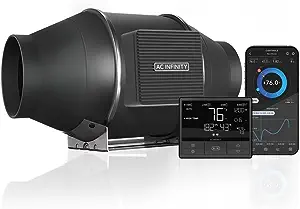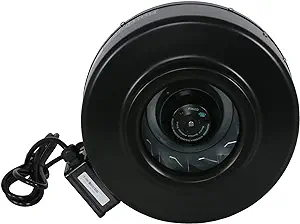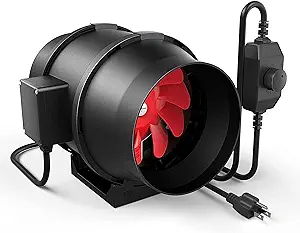Grow tents are essential for indoor gardening, providing a controlled environment for plants. However, maintaining the right temperature and air circulation is crucial for plant health and growth. This is where fans come in. Below, we review the 7 best fans for grow tents, offering a range of options for every gardener’s needs.
Tips for Choosing a Fan for Your Grow Tent
Selecting the right fan for your grow tent is crucial for maintaining the ideal environment for your plants. Here are some key tips to consider when making your choice
- Assess the Size of Your Grow Tent: The size of your grow tent will dictate the size and power of the fan you need. A larger tent will require a fan with higher cubic feet per minute (CFM) to ensure proper air circulation.
- Understand CFM Ratings: CFM, or cubic feet per minute, measures the volume of air the fan can move. Ensure the fan’s CFM rating is adequate for the size of your grow tent. A general rule is to choose a fan that can replace the air in your tent at least once every three minutes.
- Consider the Noise Level: Some fans can be quite loud, which might be an issue if your grow tent is in a living area. Look for fans labeled as “quiet” or “ultra-quiet” if noise is a concern.
- Energy Efficiency: Fans will be running for extended periods, so opting for an energy-efficient model can help reduce electricity costs in the long run.
- Adjustable Speeds and Controls: Fans with variable speed controls offer more flexibility. You can adjust the airflow based on the current needs of your plants or changes in external temperatures.
- Durability and Build Quality: A fan that is durable and well-built will last longer and provide consistent performance. Look for fans with solid construction and quality materials.
- Ease of Installation and Maintenance: Choose a fan that is easy to install and maintain. Features like detachable components or washable filters can make maintenance simpler.
- Temperature and Humidity Controls: Some advanced fans come with built-in sensors and controllers that adjust the fan speed based on the temperature and humidity levels inside the grow tent. This can be particularly useful for maintaining a stable growing environment.
- Consider the Type of Fan: Inline fans are commonly used for grow tents and are effective for air exchange. Oscillating fans, on the other hand, are great for circulating air within the tent but do not remove air from the tent.
- Budget: Finally, consider your budget. While it’s important not to compromise on essential features, there are options available at various price points.
7 best fans for grow tents
1. Vortex S-Line Ultra Quiet Fan

The Vortex S-Line stands out for its whisper-quiet operation and energy efficiency. Perfect for those who want minimal noise disturbance.
- Size: 6 inches
- CFM (Cubic Feet per Minute): 347
- Features: Energy-efficient, ultra-quiet, easy to mount
Important Note: The Vortex S-Line’s advanced aerodynamic design significantly reduces noise, making it ideal for noise-sensitive environments.
2. AC Infinity CLOUDLINE T6

Ideal for tech-savvy gardeners, the AC Infinity CLOUDLINE T6 comes with a smart controller for temperature and humidity management.
- Size: 6 inches
- CFM: 351
- Features: Smart programming, energy-efficient, mixed flow design
Important Note: Its smart controller enables automatic speed adjustment based on temperature and humidity.
3. Hurricane Inline Fan

A great choice for those needing a powerful and durable fan, the Hurricane Inline Fan is built to last and handle large grow tents.
- Size: 8 inches
- CFM: 745
- Features: High CFM, durable construction, easy installation
4. TerraBloom ECMF-100

Compact yet powerful, the TerraBloom ECMF-100 is designed for smaller grow tents where space is at a premium.
- Size: 4 inches
- CFM: 100
- Features: Compact design, energy-efficient, variable speed controller
5. iPower 6 Inch Inline Duct Fan

This fan is known for its balance between power and price, making it an excellent option for budget-conscious gardeners.
- Size: 6 inches
- CFM: 442
- Features: Cost-effective, powerful, includes mounting bracket
6. Can-Fan Max Fan Pro Series

The Can-Fan Max Fan Pro Series is a heavy-duty fan designed for larger grow tents and prolonged use.
- Size: 8 inches
- CFM: 863
- Features: High capacity, durable, three-speed switch
7. Hyper Fan Digital Mixed Flow Fan

For those who prioritize energy efficiency, the Hyper Fan offers excellent performance with minimal energy consumption.
- Size: 6 inches
- CFM: 315
- Features: Energy-efficient, lightweight, speed controller
Comparison Table
| Fan Model | Size | CFM | Key Features |
|---|---|---|---|
| Vortex S-Line | 6″ | 347 | Energy-efficient, ultra-quiet, easy to mount |
| AC Infinity CLOUDLINE T6 | 6″ | 351 | Smart programming, energy-efficient |
| Hurricane Inline Fan | 8″ | 745 | High CFM, durable construction |
| TerraBloom ECMF-100 | 4″ | 100 | Compact design, energy-efficient |
| iPower 6 Inch | 6″ | 442 | Cost-effective, powerful |
| Can-Fan Max Pro Series | 8″ | 863 | High capacity, durable |
| Hyper Fan | 6″ | 315 | Energy-efficient, lightweight |
FAQs
What is the purpose of a fan in a grow tent?
- A fan in a grow tent helps maintain air circulation, which is crucial for controlling temperature and humidity levels. It also ensures that plants receive fresh air and CO2, which are vital for photosynthesis and overall plant health.
How do I choose the right size fan for my grow tent?
- The size of the fan you need depends on the size of your grow tent and the volume of air it needs to circulate. A common rule is to choose a fan that can exchange the air in the tent at least once every three to five minutes. The fan’s CFM (cubic feet per minute) rating should match or exceed the cubic footage of your tent.
Are oscillating fans or inline fans better for grow tents?
- Inline fans are great for exchanging air in and out of the tent, which is essential for temperature and humidity control. Oscillating fans, on the other hand, are ideal for circulating air within the tent to prevent hot spots and ensure even distribution of air.
How many fans do I need in my grow tent?
- This depends on the size of your tent and the type of plants you are growing. Generally, you’ll need at least one exhaust fan (inline fan) for air exchange and one or more oscillating fans for internal air movement.
Can a fan be too powerful for a grow tent?
- Yes, a fan that is too powerful can create too much airflow, which can stress plants by causing excessive drying and could potentially damage the tent structure. It’s important to choose a fan with the appropriate CFM rating for your tent’s size.
Do I need a fan with a speed controller?
- While not mandatory, a fan with a speed controller is highly beneficial. It allows you to adjust the airflow based on the specific needs of your plants and changes in external environmental conditions.
Should my grow tent fan run all the time?
- It is generally recommended to keep the fan running continuously to maintain consistent air circulation. However, some setups might require different schedules based on the plants’ specific needs and the external environment.
How do I install a fan in my grow tent?
- Installation varies depending on the type of fan. Inline fans are typically installed at one end of the tent, either at the top or side, with ducting to guide air in and out. Oscillating fans can be placed inside the tent, ideally in a position where they can distribute air evenly without directly blowing on plants.
What is the difference between an exhaust fan and an intake fan in grow tents?
- An exhaust fan removes hot and humid air from inside the tent, while an intake fan brings fresh, cooler air into the tent. This combination helps maintain a balanced environment with adequate CO2 levels for plant growth.
How do I maintain my grow tent fan?
Regular maintenance includes cleaning the fan blades and housing to prevent dust buildup, checking for any mechanical issues, and ensuring that all connections are secure. For inline fans, you should also check and clean any connected ducting.
Conclusion
When selecting the best fan for your grow tent, consider the size of your tent, the noise level, energy efficiency, and the specific needs of your plants. The right fan will not only help regulate temperature and humidity but also ensure your plants receive fresh air, crucial for their growth and health. Remember, the health of your plants depends significantly on the environment you create for them.